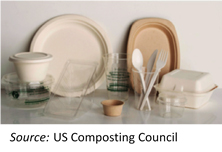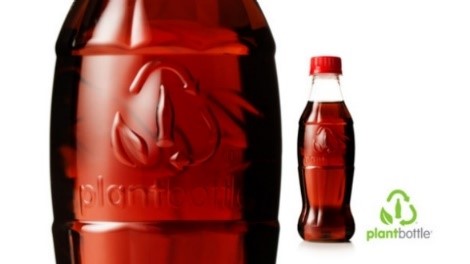August 20, 2019
This guest blog is courtesy of Debra Darby, Darby Marketing.
Recently several colleagues interested in organics recycling have asked me about the use of the terminology “biodegradable” and “compostable”, and what these terms mean. Several types of products have come out that further complicate people’s understanding including bags and food service ware items made from bioplastics and other compostable materials. I will provide some definitions and a glossary of terms for you to gain a general understanding.
What are Bioplastics?
Bioplastics are a large family of materials that can be used to make a wide variety of consumer products. A bioplastic is a plastic that can be biodegradable, has biobased content, or both. Bioplastics is a term which encompasses two categories:
- Bioplastic made from renewable resources. Here the origin of the raw materials used to make bioplastics, typically from biomass including industrial sugars and starch, is considered biobased.
- Bioplastic that is biodegradable and compostable according to the ASTM International industry standards of D6400 and the related European EN 13432. Here the source material can be either biobased (new carbon) or non-renewable (old carbon including natural gas and oil).
The biodegradability of a bioplastic is due to the chemical structure of the polymer and not based on the source of carbon (new versus old). Bioplastics may be biobased and biodegradable. Bioplastics may be biobased but not biodegradable. Bioplastics may be based on non-renewable resources and biodegradable.
Biodegradable and Compostable
Biobased materials that are biodegradable are used to make compostable  products such as bags, take-out containers, coffee pods, food packaging, cups, plates and cutlery. Some compostable consumer products are made from bioplastics that are based on non-renewable feedstocks.
products such as bags, take-out containers, coffee pods, food packaging, cups, plates and cutlery. Some compostable consumer products are made from bioplastics that are based on non-renewable feedstocks.
ASTM International industry D6400 test method standards are used to qualify plastic materials and products as compostable in industrial composting facilities. ASTM D6400 is a set of three tests that a plastic must meet pass/fail criteria for compostability in an industrial composting facility. A product that passes this standard specification can claim to be compostable. The material and the product made from that material:
- Must physically disintegrate to the extent that it cannot be “readily distinguishable” from the finished compost product.
- Must actually biodegrade (be consumed by microorganisms) at a rate comparable to known compostable materials.
- Cannot have adverse impacts on the ability of the compost to support plant growth.
The Biodegradable Products Institute (BPIworld.org) is North America’s leading certifier of compostable products and packaging. This third-party certification  program uses independent labs and an accredited technical reviewer to determine whether materials and products meet the ASTM D6400 standards for compostability. This ensures that products and packaging displaying the BPI logo have been independently tested and verified according to scientifically based standards.
program uses independent labs and an accredited technical reviewer to determine whether materials and products meet the ASTM D6400 standards for compostability. This ensures that products and packaging displaying the BPI logo have been independently tested and verified according to scientifically based standards.
A new testing service is The Compost Manufacturing Alliance (CMA) field  testing program. Members of the CMA work to support this program for maintaining a high standard of compost quality across 20 composting facilities throughout the U.S. This organization offers real-world input from an industry perspective as distinct from a laboratory standard.
testing program. Members of the CMA work to support this program for maintaining a high standard of compost quality across 20 composting facilities throughout the U.S. This organization offers real-world input from an industry perspective as distinct from a laboratory standard.
All products marketed as compostable must have a certification label from BPI, and ideally also from CMA to ensure that products are fully compostable at industrial composting facilities. It makes sense where there is food service and food waste collection that certified compostable products should be used.
Biobased and Non-Biodegradable
Biobased materials that are not biodegradable include Bio-PE, Bio-PP and Bio-PET. These materials can be recycled. It is the polymerization process of the biobased material that enables it to perform like conventional plastic PE, PP or PET. The significant difference is in the origin of the feedstock used to make the biobased material.

One commercial example of Bio-PET is Coca-Cola’s PlantBottle that debuted in 2009 at 30% biobased. This is considered a drop-in technology because the bottle is designed to work within the existing recycling infrastructure. In 2015 Coca-Cola demonstrated a PlantBottle from 100% biobased to create a fully recyclable plastic bottle made from renewable materials, sugarcane. PlantBottle® packaging is an example of The Coca-Cola Company’s vision to develop a more responsible plant-based alternative to packaging traditionally made from fossil fuels and other non-renewable materials.Another example is Bio-PE from Braskem, a chemical company. Its HDPE and LLDPE covers the rigid packaging application, caps and closures. Bio-PE is recyclable in the existing recycling stream. At the 2019 International Toy Fair in Germany, the toy manufacturer Ferbedo debuted a toy car made from Bio-PE. Ferbedo designs its toys to be durable, long-lasting and be passed down in families. If the toy ends up in the waste stream, it can be recycled or turned into renewable energy at an energy-from-waste facility.
In 2018, Ikea and Neste announced a pilot project to incorporate Bio-PP. The  new biobased plastic will be used in several of Ikeas products, such as plastic storage boxes. IKEA is working to change all of the plastic used in IKEA products to plastic based on recycled and/or renewable materials by 2030.
new biobased plastic will be used in several of Ikeas products, such as plastic storage boxes. IKEA is working to change all of the plastic used in IKEA products to plastic based on recycled and/or renewable materials by 2030.
Difference Between Biodegradable and Compostable
Everything that is compostable is biodegradable. Not everything that is biodegradable is compostable.
Most materials will biodegrade when given enough time. The length of time for biodegradation is dependent on environmental parameters where that material will be disposed. The disposal environment where biodegradation is intended to take place must be specified along with a timeframe consistent with the ambient conditions of that environment whether it be in soil, water, landfill, or home and industrial composting environments.
Claiming biodegradable means nothing without providing the conditions in which the item will biodegrade. For example, if a marketing claim for a product is biodegradable in soil, then the timeframe that it takes for the material to fully biodegrade in soil must be stated. Marine biodegradable is not acceptable unless the product is certified to biodegrade in a marine environment within a specific amount of time. California has banned products that claim “biodegradable” without stating what environment and how long it takes for it to biodegrade. Making a deceptive claim that a product or material is biodegradable without indicating in what environment and in what timeframe is considered greenwashing and misleading to consumers. Ideally a biodegradable product should be application specific, and not just a waste disposal option. One example is certified soil biodegradable agricultural mulch films where the film is plowed into the soil after harvest.
Compostable is a subset of biodegradable. Compostable means that an item will turn into nutrient-rich soil within a specific timeline. Certification standards require specific timelines in order for products to be called compostable.
As we push cultural and behavior change toward zero waste and sustainable living, the market place will also need to change to a restorative place of commerce. One that is non-destructive, supports innovation and product development based on renewable and reusable resources. This will take a paradigm shift from the current linear consumption and waste disposal infrastructure to one that embraces circular economic values and reduction in carbon emissions. There are some market drivers as indicators including extended producer responsibility (EPR) and organics recycling that are pivoting us toward that direction.
GLOSSARY OF TERMS
Biobased: A product determined to be commercial or industrial product other than food or feed that is composed of, in whole or in significant part, of biological products or renewable domestic agricultural materials (including plant, animal, and marine materials) or forestry materials. Source: USDA, Section 9002 of the Farm Security and Rural Investment Act of 2002
Biobased: The focus here is the raw material basis. Rather than using fossil carbon in manufacturing conventional plastics, biobased plastics use non-fossil carbon. In general, this involves the use of renewable resources such as sugars, starch, vegetable oils, or cellulose in production. The proportion of non-fossil renewable carbon used in the product can be determined using analytical methods. Biobased plastics do not necessarily have to be biodegradable and compostable. Source: European Bioplastics
Biobased Content: The amount of biogenic carbon (carbon from biological sources as opposed to petrochemical-based carbon) in the material or product as a fraction weight (mass) or percent weight (mass) of the total organics carbon in the material or product. Biobased content will be determined by testing representative product samples using the generally accepted methodology of ASTM International D6866. Sources: USDA BioPreferred Program; H.R. 3586, Duncan Biomaterials Tax Credit Bill
Biodegradable: The degradation of material from naturally occurring microorganisms, such as bacteria, fungi, or algae, over a period of time. Source: ASTM International
Biodegradable: The ability of a substance to be broken down physically and/or chemically by microorganisms. For example, many chemicals, food scraps, cotton, wool, and paper are biodegradable; plastics and polyester generally are not. Source: EPA
Biodegradable: Claims of degradability, biodegradability, or photodegradability should be qualified to the extent necessary to avoid consumer deception about: (1) the product or package’s ability to degrade in the environment where it is customarily disposed; and (2) the rate and extend of degradation. Source: Federal Trade Commission Marketing Claims (16 CFR Part 260)
Biodegradable Plastic: A plastic in which all the organic carbon can be converted into biomass, water, carbon dioxide, and/or methane via the action of naturally occurring microorganisms such as bacteria and fungi, in timeframes consistent with the ambient conditions of the disposal method. Source: ASTM International
Compostable: Claims of compostability should be qualified to the extent necessary to avoid consumer deception. An unqualified claim may be deceptive if: (1) the package cannot be safely composted in a home compost pile or device; (2) the claim misleads consumers about the environmental benefit provided when the product is disposed of in a landfill. A claim that a product is compostable in a municipal or institutional composting facility may need to be qualified to the extent necessary to avoid deception about the limited availability of such composting facilities. Source: Federal Trade Commission Marketing Claims (16 CFR Part 260)
Compostable Plastic: Plastic that undergoes biodegradation by biological processes during composting to yield CO2, water and biomass at a rate consistent with other known compostable materials and leaves no toxic residue. Source: ASTM International
Compostability: A characteristic of a product that enables biodegradation under specific conditions (i.e. certain temperature, timeframe, etc.). At the end of this process, for example in an industrial composting plant, only natural products remain (water, carbon, biomass). Currently, the distinction is made between industrial and home composting. The specific criteria for industrial compostability of packaging materials, such as the environment, temperature, and timeframe, have been defined in EN 13432 (or equivalent ASTM D6400). Materials and products complying with this standard can be certified and subsequently labelled accordingly with the Seedling label. There is currently no European standard for home composting. Yet, national regulations, standards, or certification programmes do exist in Italy (UNI 11183), Austria (TÜV OK compost HOME, formerly Vinçotte) and the United Kingdom. Source: European Bioplastics
For a more extended Glossary of Basic Terms, see Bioplastics Magazine.
NERC welcomes guest blog submissions. To inquire about submitting articles contact Lynn Rubinstein.
Disclaimer: Guest blogs represent the opinion of the writers and may not reflect the policy or position of the Northeast Recycling Council, Inc.


Comments (0)
Add a Comment